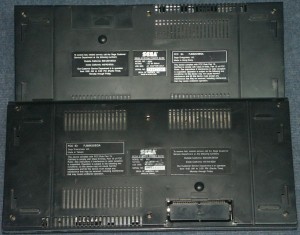 It was recently confirmed that Sega has flipped the switch on its famous customer service line, 1-800-USA-SEGA, and frankly, it’s the end of an era. For more than two decades, the number was available for gamers and fans to use for all sorts of queries, comments, and problems. Now, it’s gone, and I feel like another chapter of my childhood has closed. The Internet has made that long-lived staple of gaming, the tip line, a relic of the past, and one of the last bastions of old school customer support is no more.
It was recently confirmed that Sega has flipped the switch on its famous customer service line, 1-800-USA-SEGA, and frankly, it’s the end of an era. For more than two decades, the number was available for gamers and fans to use for all sorts of queries, comments, and problems. Now, it’s gone, and I feel like another chapter of my childhood has closed. The Internet has made that long-lived staple of gaming, the tip line, a relic of the past, and one of the last bastions of old school customer support is no more.
Gamers who came to know Sega in the Saturn or Dreamcast era may still remember the number nestled in manuals or tech documents. Those of us who were reared on the Master System remember seeing those unforgettable digits on the bottom of their console, and using them got you more than just a pleasant person at the other end. Calling Sega could often result in a nice little envelope of gaming goodness, sent right to your door by the good people in San Francisco.
Tips, Tricks, and More
When a Sega gamer picked up the phone and called the company, it was for one of several reasons. First, he was likely going to ask about upcoming game releases, and the customer service representative on the other end usually obliged with a short statement about soon-to-be-released titles. Second, he may have had a technical problem with his hardware, and a call to Sega netted instructions on how to send the machine in for repair. The third reason was perhaps the most common, and it was by far the one that yielded the coolest results. When you called Sega for game tips, the representative was able to help you out of a jam in a calm and cool fashion – for free. That’s right! Since this was a 1-800 number, there was no danger of racking up long distance charges (unlike with other tip lines of the era). You could call as many times as you wanted and never had to worry about facing mom’s wrath.
The best part about it was that if you called often enough about the same game, or if the representative wasn’t able to steer you in the right direction over the phone, they would send you some awesome tip sheets in the mail. These were photocopied pages of information with different parts of the game you inquired about, and while they may look ghetto now, it was absolutely AWESOME back in the day to get an envelope from Sega (it was actually awesome to get mail at all. Think about it: How much mail did you get when you were 10?). These neat little sheets were packed with directions, tips, and secrets. They had screen shots and maps, and many even had artwork scattered across them. The only way to obtain these little gems was by calling Sega directly.
I recently came into a small selection of these pages and made a video about them. To think that Sega would send these to you simply because you asked it to, and for free, is something today’s gamers will never have the chance to experience. Dealing with game publishers directly seems so impersonal now, but Sega’s great customer support was a vital part of its business back in the ‘80s and early ‘90s because it was really the main focus of what many American Sega employees did. From the Master System’s run until shortly before the debut of Sonic, Sega of America was basically a customer service desk and repair depot. There was no domestic game development going on yet, and aside from the localization of titles from Japan, Sega employees were charged with keeping hardware working and customers happy. And this they did in stellar fashion. All the customer support representatives were female at this early period in Sega of America’s life, and some were as young as 18!
I used the number extensively back when I had my Master System. I was a true scrub and had problems with many games. In my defense, many of them were hard! I took advantage of the free number and called often. There were four women working the lines during this period: Sharon Rao, Heidi Marc, Terri Alba, and Judy Jetté. I likely spoke to all of them at one point or another, as they helped me defeat Medusa in Phantasy Star, beat the last level in Rambo II, and taught me to use the hammer in Ys: Vanished Omens. Thinking about it now, I probably wouldn’t have finished half the games I did had it not been for these wonderful women.

So Long, Dear Friend
I still remember the last time I used the number. I was struggling with the last boss in Super Hydlide. I could cripple his legs but not kill him. Nothing I did seemed to work. I was at my wit’s end until I remembered good ol’ 1-800-USA-SEGA. I called and was kindly directed to let the creature eat me. I explained just how dumb that sounded, but the confident representative told me to trust her. I did and discovered that attacking from inside the monster’s mouth was the only way to finish it off. I completed the game and was so happy that I had to call back and thank her. Another representative answered the phone, but she was nice enough to listen to my excited rant and transfer me over to the girl who had attended my earlier call. I got to thank for her help, and even though I knew she was just doing her job, I felt like I had to give her credit for getting me out of a jam. She laughed and said something to me that I never forgot:
“Thanks for calling Sega. Remember, we’re always here if you need us.”
Not anymore, my friend… not anymore…
Master System console images property of Classiccmp.org.

this is a great article. ^^ maybe it’d be possible to interview one of these representatives, or one from any period. i bet they have the funniest stories to tell. =D
Excellent write-up! I’d used this a few times in the day, and they were indeed most helpful…later on, I’d just call the # when bored/waiting on the bus near a payphone to hear upcoming titles! Really cool getting more info on this lost service, thanks for that.